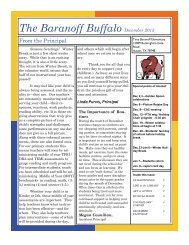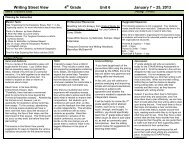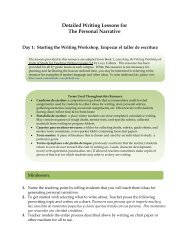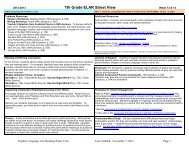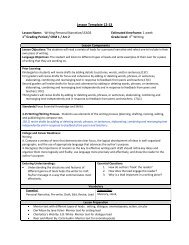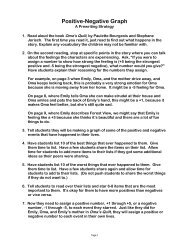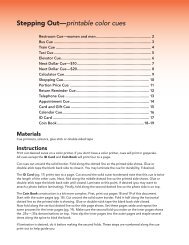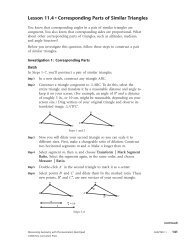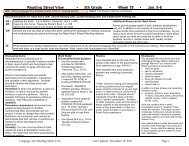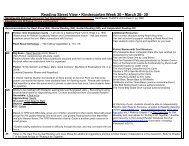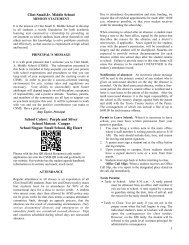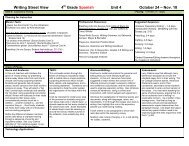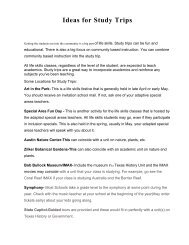Tiered
Tiered
Tiered
You also want an ePaper? Increase the reach of your titles
YUMPU automatically turns print PDFs into web optimized ePapers that Google loves.
Course: Grade 7Model Lesson for Middle School ELARGrading Period: 2nd Six Weeks Unit: Exploring Imagination Arc: Imagination in Reading 2010 – 2011Lesson Title: <strong>Tiered</strong> Characterization LessonTEKS: 7.19A, 7.190B, 7.190C, 7.190D, 7.190E, 7.2A, 7.6B, 7.6CELPS: 1C, 1E, 2C, 2G, 3E, 3G, 3J, 4G, 4I, 4J, 4K, 5BCCRS: Reading A4, B1, C1, C4, D1Lesson Components: Lesson Plan, Building Academic Vocabulary Template (Marzano from 1 st Six Weeks), Differentiated Group Questions, CharacterizationGraphic OrganizerPacing: 3 daysVocabulary: characterization , inference(review) connotation, denotationResources: “Thank You, M’am” (p. 66 Holt McDougal Literature 7 th Grade)Readers’ Writers’ NotebookChart Tablet paper/markersTeachers Do:1. Direct students to answer questions in their RWN (Readers’/Writers’Notebook): Think about a person or people who see the best in youeven when you can’t seem to do anything right. How do they let youknow that they believe in you? What do they say that makes you feelbetter? What things do they do that show you they believe in you?Instructional StepsStudents Do:1. Students read prompt from board and write response in RWN.2. Students share their answers orally.3. Complete Academic Vocabulary Template.2. Model with your own answer. Ask students to share.3. Introduce concept of characterization—how an author portrays acharacter by their actions, words, thoughts. (Connect back to RWNresponses). Have students complete Academic Vocabulary Templatefor the word characterization. (Characterization includes what acharacter says, what a character thinks, what a character looks like,what a character does, what others think of the character.) Modelprocess along with students.4. Pass out Differentiated Questions:• Group 1 questions go to struggling students/ELLS.• Group 2 questions go to middle students.• Group 3 questions go to students who need to be challenged.Explain that students will need to be able to answer questions on theirslips of paper AND give evidence from the story to support theiranswers once they have read the story. Ask students to read theirquestions silently. Students may ask to have anything clarified.5. Introduce the story “Thank You M’am.” Hook students by asking ifanyone ever got caught doing anything wrong. Explain that in thisstory, a boy meets a woman when he gets caught doing somethingwrong. Set purpose for reading by asking students to think about howthe author gives clues about the characters. Read story aloud, or have4. Read questions silently—ask if there is anything unclear aboutquestions.5. Read story.6. Students answer questions. (This can be done independently or ingroups—all the 1’s together, all the 2’s together, etc.)7. Students provide answers for summary and write in RWN.8. Students answer questions and copy teacher modeling into chart.Students complete left side of chart alone or with a partner.9. Students offer inferences and justify them.10. Students decide as a class on a word that describes Mrs. Jones.Students scribe a class paragraph on a piece of chart paper in whichthey support their descriptive word by using ideas from their charts.Students who are not scribing may copy the paragraph into their RWNso they have a good example of how to write about literature.© 2010 Austin Independent School District Course: 7 th Grade Page 1 of 3 6/22/10
Course: Grade 7Model Lesson for Middle School ELARGrading Period: 2nd Six Weeks Unit: Exploring Imagination Arc: Imagination in Reading 2010 – 2011Lesson Title: <strong>Tiered</strong> Characterization Lessonstudents read silently, or have them read together in small groups.6. Monitor student reading. Monitor student writing answers to questions.If students are in groups, monitor to make sure everyone is on task andparticipating.7. Ask for brief summary of story. A possible sentence stem for thesummary is : ___ wanted ___, but ___ so___Example: Roger wanted to get some blue suede shoes, but he didn’thave any money, so he stole Mrs. Jones’s purse then she caught him.8. Pass out characterization chart. Model completing chart by solicitinganswers from students for the questions on the left side of the chart.(Use ELMO or Overhead Projector) Walk students through completingthe right side of the chart (reinforces inference skills) by completing thefirst 1 or 2 together, with students providing answers orally. Then havestudents complete the rest of the chart alone or in pairs while youmonitor.9. Discuss student inferences on right side of chart.10. Ask the class to decide on one or two words that would describe orcharacterize Mrs. Jones. On a piece of chart paper, have volunteersscribe. The class will write a paragraph in which they describe Mrs.Jones and support their descriptive word with evidence from the text(which they have written on their charts.)Next Step: Student will use the same character analysis tools(graphic organizer and questions) to analyze a character fromanother reading selection.Differentiated Instruction:• Questions for author’s characterization of Mrs. Jones are differentiated for struggling students, on-level students, and students who need to be challengedEvidence of LearningObservation: Teacher circulates and monitors during reading and independent work, evaluates quality of answers students offer for summary, filling in chart, andwriting paragraph.Formative Assessment: RWN, Class paragraphStudent Work Products/Rubric:Summative Assessment/Rubric:Other: Class discussion and comments/questions regarding characterization and inference.© 2010 Austin Independent School District Course: 7 th Grade Page 2 of 3 6/22/10
Characterization: Mrs. Luella Bates Washington JonesWhat she looks like: (Give a quote, the page number, and theline number)1.What does this tell us about her?1.2.2.What she says: (Give a quote, the page number, and the linenumber)1.What does this tell us about her?1.2.2.
Characterization: Mrs. Luella Bates Washington JonesWhat she thinks (Hint: Look for clues, goals): (Give a quote, thepage number, and the line number)1.What does this tell us about her?1.2.2.What Roger thinks (Hint: Look for clues): (Give a quote, thepage number, and the line number)1.What does this tell us about her?1.2.2.
Characterization: Mrs. Luella Bates Washington Jones
Group # 1Step 1: Read the story “Thank you M’am” by Langston Hughes.Step 2: Think about the character Mrs. Luella Bates WashingtonJones. Answer your questions using evidence from the story. Youmay use the author’s exact words, or you may paraphrase(summarize or say the main idea in your own words.)Be sure to give the page number and the line number that showswhere you got the idea for each answer.Describe:-How the character looks:-What the character says:-How the character thinks or acts:-The most important thing to know about the character:
Group # 2Step 1: Read the story “Thank you M’am” by Langston Hughes.Step 2: Think about the character Mrs. Luella Bates WashingtonJones. Answer your questions using evidence from the story. Youmay use the author’s exact words, or you may paraphrase(summarize or say the main idea in your own words.)Be sure to give the page number and the line number that showswhere you got the idea for each answer.Describe:-What the character says or does:-What the character really means to say or do:-What goals does the character have?-What the character would mostly like us to know about himor her:-What changes the character went through:
Group # 3Step 1: Read the story “Thank you M’am” by Langston Hughes.Step 2: Think about the character Mrs. Luella Bates WashingtonJones. Answer your questions using evidence from the story. Youmay use the author’s exact words, or you may paraphrase(summarize or say the main idea in your own words.)Be sure to give the page number and the line number that showswhere you got the idea for each answer.Describe:-Clues the author gives us about the character:-Why the author gives these clues:-The author’s bottom line about this character:



